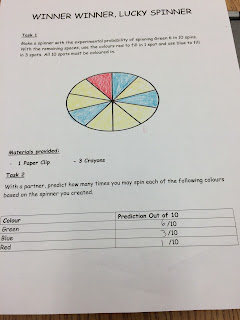Working with Patterns & Algebra
hey guys,
So today we were leaning about balancing algebraic equations. One example was 3b+ 1=2b+7. Using a scale you would figure out what b is. To write this equation out and figure the out you need to break it down by subtracting first. It we take away 1 it would work out to be 3b-1=2b-1 which would then equal 3b=2b+6 and trying to figure out how to isolate b. next we would take away 2 bags to get 1b=6. This would let us know that for every bag you need 6 blocks. Then we can plug in 6 for the b so the equation would now be 3(b+1)=2(6)+7.
The activity I was given was brought up by Nadine. She also talked about balancing algebraic equations to make the expressions true. We used a scale to figure out what the missing numbers were (the sheet of examples is below). She set out rules that [] and delta can not equal 0 so there had to be a number on both sides that were greater than 0. When using the scales we found it easier to make sure that they balanced each other out to make sure that our expression was true. This would be great for kids that needed tangible things and visual things to figure out if they're expression is true.
Another activity was based on patterning. Learning how to pattern using a staircase number. First step is to show a visual of the pattern of the staircase by drawing. Then the second step was to express using numbers. The third part was to build it using manipulatives. Then in the fourth part they needed to find a growing and shrinking pattern using addition, subtraction, multiplication and division.
Next we had an activity on working with patterns the easy way. In each question you need to put the numbers in the correct order to show a growing pattern between each number. Using the patterns from the first questions you can answer the second questions.
What all of these students tried to do was give the students tasks to build on to their knowledge in order to answer harder and harder questions as they went. This gives students the ability to keep working through different components and keep building on the knowledge they acquire during lessons.
We also went over a quick lesson on how to figure out patterns. We used this pattern to figure out how we would find what future answers would be. So for this case she gave us the first 5 patterns and then we had to find the 10th term. So based off the first 5 patterns I noticed that there was an addition of 1 block per side (so one on top and one on the side) so for the 10th addition we could either follow the pattern 10 times for visual learners or we could develop a formula to find it.
Well that's all for today. Come back next time as we keep moving forward in our math journey.
So today we were leaning about balancing algebraic equations. One example was 3b+ 1=2b+7. Using a scale you would figure out what b is. To write this equation out and figure the out you need to break it down by subtracting first. It we take away 1 it would work out to be 3b-1=2b-1 which would then equal 3b=2b+6 and trying to figure out how to isolate b. next we would take away 2 bags to get 1b=6. This would let us know that for every bag you need 6 blocks. Then we can plug in 6 for the b so the equation would now be 3(b+1)=2(6)+7.
 |
Zahabi, N. Oct. 27th 2017. "Balancing equations."
Retrieved from my own library.
|
Another activity was based on patterning. Learning how to pattern using a staircase number. First step is to show a visual of the pattern of the staircase by drawing. Then the second step was to express using numbers. The third part was to build it using manipulatives. Then in the fourth part they needed to find a growing and shrinking pattern using addition, subtraction, multiplication and division.
Next we had an activity on working with patterns the easy way. In each question you need to put the numbers in the correct order to show a growing pattern between each number. Using the patterns from the first questions you can answer the second questions.
What all of these students tried to do was give the students tasks to build on to their knowledge in order to answer harder and harder questions as they went. This gives students the ability to keep working through different components and keep building on the knowledge they acquire during lessons.
 |
Doucette, K. Oct. 27th, 2017. "Using manipulatives for patterns"
Retrieved from my own personal library.
|
Well that's all for today. Come back next time as we keep moving forward in our math journey.



Comments
Post a Comment